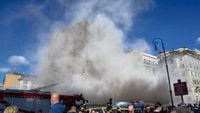On Monday, November 3, 2025, the heart of Rome was rattled by a tragedy that unfolded at the Torre dei Conti, a medieval tower standing just steps from the Colosseum. The centuries-old structure, which had been undergoing a major restoration, partially collapsed in a dramatic sequence of events that left one worker dead and another seriously injured. The incident has sent shockwaves through Italy, prompting official mourning and a criminal investigation, while raising difficult questions about the safety of restoration projects on the city’s ancient landmarks.
The Torre dei Conti, built in 1283 by Pope Innocent III as a residence for his family, has long been a silent witness to Rome’s turbulent history. Rising nearly 100 feet, the tower was once a papal residence and, in more recent times, served as offices until its closure in 2007 due to disrepair. On that fateful Monday, however, the ancient stones gave way during ongoing conservation work, trapping workers inside and igniting a frantic rescue operation that would last nearly 11 hours.
According to The New York Times and the Associated Press, the collapse began before noon when the central buttress on the southern side of the tower crumbled, sending an underlying sloped base tumbling down. Three workers were rescued unharmed in the immediate aftermath, thanks to the swift response of the fire brigade. But for two others, the situation was dire. One worker, age 64, was hospitalized in critical condition with a broken nose, while another, identified as Octay Stroici—a Romanian national and member of the restoration team—remained trapped beneath a mountain of debris.
Rescue efforts quickly became a race against time. About 140 firefighters descended on the scene, employing cranes, ladders, and even a drone to assess the precarious situation. As dusk settled over Rome, firefighters used giant tubes to vacuum rubble from a second-floor window, working with painstaking care to avoid further destabilizing the structure. The operation was fraught with setbacks; at one point, a second collapse struck, damaging a stairwell and the roof, and sending up a cloud of dust that forced rescuers to retreat. “The operation lasted a long time because every time a part of the body was freed there was additional rubble that covered it," Lamberto Giannini, the prefect of Rome, told reporters, as cited by the Associated Press.
Throughout the ordeal, hope lingered that Stroici might survive. Rome Mayor Roberto Gualtieri told reporters that the trapped worker was able to speak to rescuers and was using an oxygen mask. “Rescuers were working with extreme caution in ‘a very delicate extraction operation’ to avoid further collapses,” Gualtieri said, according to RAI and the Associated Press. Images broadcast on local television showed rescuers loading Stroici onto a telescopic aerial ladder and wheeling him into an ambulance. Tragically, the joy of his extraction was short-lived. Stroici succumbed to his injuries soon after being rescued, a loss that reverberated through the city and beyond.
Italian Prime Minister Giorgia Meloni expressed the nation’s grief in a statement released after midnight. “I express deep sorrow and condolences, on behalf of myself and the government, for the tragic loss of Octay Stroici, the worker who was killed in the collapse of the Torre dei Conti in Rome. We are close to his family and colleagues at this time of unspeakable suffering,” Meloni said, as reported by the Associated Press and The New York Times. Earlier in the day, Meloni had shared her hopes for a successful rescue, stating, “My thoughts and deepest sympathies go out to the person currently fighting for his life under the rubble and to his family, for whom I sincerely hope that this tragedy will have a positive outcome. I would like to thank all the law enforcement officers, firefighters, and rescue workers who are intervening with courage, professionalism, and dedication in this extremely difficult situation.”
Rome’s mayor, Roberto Gualtieri, declared Wednesday, November 5, a day of mourning in honor of Stroici. “On behalf of Rome Capital and myself, I extend my heartfelt thoughts to his family, colleagues, and all those close to him. I would like to thank the firefighters, law enforcement, and rescue workers who responded with great professionalism and dedication in such a complex and dramatic situation,” Gualtieri said in a statement published by ARTnews.
The collapse drew crowds of tourists and locals alike, many of whom watched in shock as the rescue unfolded. Queen Paglinawan, who was working in a nearby gelato shop, described the moment the tower began to crumble: “I was working and then I heard something falling, and then I saw the tower collapse in a diagonal way,” she told the Associated Press. German student Viktoria Braeu, passing by after a tour of the Colosseum, recalled, “And then we were like, ‘It’s probably not long until it's going to go down,' and then it just started erupting.”
The Torre dei Conti’s restoration, which began in 2022 with nearly $8 million earmarked for the project, was intended to stabilize the structure and eventually open it as a museum dedicated to the most recent phases of the Imperial Fora and as a service center for the Central Archaeological Area. The work included conservation, installation of new electrical and water systems, and asbestos removal. According to city officials, structural surveys and load tests were conducted before work began, confirming the safety conditions necessary to proceed. The current phase, costing about $460,000, was nearly complete at the time of the disaster.
Despite these precautions, the collapse has prompted an immediate investigation. Italian prosecutors arrived at the scene as rescue operations were underway, launching an inquiry into possible charges of negligent disaster and negligent injuries. As ARTnews notes, it is common in Italy for investigations to begin during or immediately after such events, even before any suspects are identified.
The Torre dei Conti has weathered centuries of turmoil, including damage from a 1349 earthquake and further collapses in the 17th century. But this latest tragedy has cast a shadow over Rome’s ongoing efforts to preserve its architectural heritage. The city’s ambitious plans to reopen the tower to the public as a museum now face uncertainty, as officials grapple with the aftermath and the pressing need to ensure the safety of restoration workers and visitors alike.
For now, Rome mourns the loss of Octay Stroici—a worker whose tragic death has become a somber reminder of the risks inherent in safeguarding the past for future generations.




